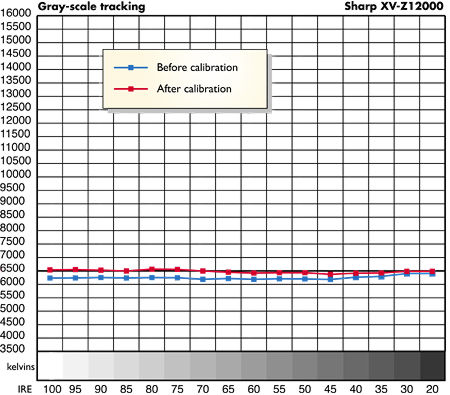Sharp XV-Z12000 DLP projector Calibration
Displaying a signal from our Leader HD generator, the Sharp XV-Z12000 resolved a full 1280 x720 pixels. Overscan averaged about 3.5% with a component input, less than 1% with DVI.

As with Sharp's XV-Z10000, you can't really use the Color Management System or Gamma controls properly without at least a color analyzer, but they do provide useful adjustments for those so equipped. The Hue control in the CMS system lets the user shift the color points slightly (though the range is limited). The Lightness control can compensate for push in any of the colors. After I adjusted these controls, using our Photo Research spectroradiometer for tweaking the color, the red color point was just a little deeper into red than it should be, but not by much. Green was a little minus yellow, and a little more richly green than the standard calls for. Blue was nearly perfect.
The as-delivered color temperature (after switching to the 6500K setting—our sample came set to 8500K!) is shown in the accompanying figure. After I'd calibrated the XV-Z12000 using the Gamma Gain and Gamma Offset controls in the user menu, the biggest improvement was not in the kelvin numbers (After), but in how close the results came to the ideal D6500 point. (Remember that "6500K" is a line on the CIE color chart, not a point, and that the point we want is D6500, or D65.) The calibrated Z12000 came about as close to a perfect D65 across the full brightness range as any projector we've measured. Spot-on color requires both D65 across the full brightness range and perfectly located color points. We have yet to meet a projector that meets both of these criteria perfectly, but the Sharp came respectably close.
At the Medium iris setting with Economy mode Off, I measured a peak contrast of 3225 on the Stewart FireHawk screen (peak white 12.9fL, input off 0.004fL)—less than Sharp claims (5000), but still exceptionally good. With the iris at High Contrast and Economy Off, the peak contrast increased to 3935 (7.87fL full white, 0.002fL input off), but the picture was far too dim to be watchable from my seat. At Medium iris, Economy off, the 16-square checkerboard ANSI contrast measured 154.
Switching to High Brightness mode with Economy Off increased the peak-white level to 26fL! But this cut the contrast roughly in half, and more than tripled the light output at full black. This option might be useful for those who insist on viewing with room lights on, but I can't help wondering if the bulb Sharp uses is brighter than is needed by those of us who do our serious viewing in a light-controlled room. A smaller bulb might further improve the contrast under these conditions and would run cooler, making possible a slower, quieter fan. I also wonder if the Medium-contrast iris setting might have been better positioned at a slightly higher level—perhaps 20%. This would allow the use of the Economy mode (which cuts light output by 20%) and still provide the same light output, along with a useful increase in contrast through a reduction in the black level—as you'd get with a smaller bulb.
For the experienced installer or the adventuresome owner, Sharp provides a CD-ROM with the XV-Z12000: the SharpVision Manager, v.2.0. When this program is loaded on your computer, it allows full computer control of the projector, including a graphical readout for gamma. The documentation on the CD provides full details of how to use the program, but it doesn't actually explain how to optimize the projector's perfor-mance; you still need test equipment to properly adjust many of the controls, including Gamma, Gamma Gain and Offset, and CMS.—TJN
- Log in or register to post comments




































































